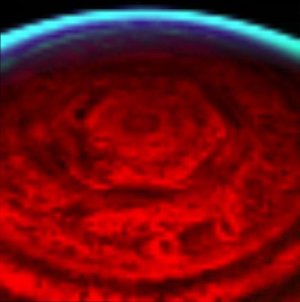Shrouded in the night of a 15-year winter, Saturn’s north pole demands specialized instruments to yield its secrets. Enter Cassini’s visual and infrared mapping spectrometer, whose data on the region have disappointed no one. A six-sided honeycomb-shaped feature has emerged that was first found by the Voyager 1 and 2 spacecraft over twenty years ago. Now Cassini has, for the first time, captured the entire hexagon in a single image.
What exactly is it? Think of Earth’s polar regions, where winds move in a circular pattern around the pole, but ponder this difference: Saturn’s vortex is a hexagon nearly 25,000 kilometers across. Four Earths would fit inside it. Click here for a QuickTime movie of the odd feature.

This makes Saturn possibly the Solar System’s most intriguing object when it comes to polar anomalies. The south pole sports an enormous hurricane, while the north is dominated by clouds moving along the hexagon at great rate. Indications are that the hexagon extends fully 100 kilometers below the cloud tops, leaving us with yet another outer system surprise.
Image: In the new infrared images, the strong brightness of the hexagon feature indicates that it is primarily a clearing in the clouds, which extends deep into the atmosphere, at least some 75 kilometers (47 miles) underneath the typical upper hazes and clouds seen in the daytime imagery by Voyager. Thick clouds border both sides of the narrow feature, as indicated by the adjacent dark lanes paralleling the bright hexagon. This and other images acquired over a 12-day period between Oct. 30 and Nov. 11, 2006, show that the feature is nearly stationary, and likely is an unusually strong pole-encircling planetary wave that extends deep into the atmosphere. Credit: NASA/JPL/University of Arizona.
Cassini team member Kevin Baines (JPL), who works on the spacecraft’s visual and infrared mapping spectrometer, has this to day:
“This is a very strange feature, lying in a precise geometric fashion with six nearly equally straight sides. We’ve never seen anything like this on any other planet. Indeed, Saturn’s thick atmosphere where circularly-shaped waves and convective cells dominate is perhaps the last place you’d expect to see such a six-sided geometric figure, yet there it is.”
It’s clear by comparing the results of Cassini’s infrared mapping with what the Voyagers found that the hexagon has remained fixed with Saturn’s rotation rate and axis for the last 26 years. The waning northern hemisphere winter may bring the feature into visual camera range within about two years, helping us get a better read on the rotation rate of Saturn’s deep atmosphere. Whether that will unlock further clues as to the actual rotation rate of the planet remains to be seen.


And check out this wallpaper image of Rhea against
the orb of Saturn:
http://www.saturndaily.com/reports/Orb_Of_Ice_999.html
Maybe this is the super-secret location of the successor to the DOD’s Pentagon headquarters?
:-)
Frank! Good to see you, old buddy. We’re all waiting for Google Saturn at this point — for those who haven’t found it yet, that’s a reference to Frank’s outstanding blog on Google Earth:
http://www.gearthblog.com
Anyone who recalls the Doc Savage pulps may also throw in a suggestion that we’re looking in the Saturn pic at the new location of the Fortress of Solitude…
Iain M Banks has a take on this too. Read ‘The Algebraist’ (great fun) and you’ll know what I mean.
P
Is it a magnetic field induced anomally? Perhaps a gigantic snowflake? Could the coldness of the sunless atmosphere induce a gigantic crystaline structure/condensate? Weird.
I have seen ferrofluids act in a similar manner under the influence of rotating magnetic fields. Many complex and reapeting patterns are produced undersuch conditions. If it is cold enough and if some portions of atmospheric constituents are paramagnetic, could such atmospheric structures form? Also, what would the influence of the moons gravitation fields have to produce tehse structures, if any? More questions than answers….
Joseph
I suppose it might be a standing wave based on convection, but how could it remain so symmetrical?
Phil, thanks for the tip. I’m looking forward to ‘The Algebraist.’ The readers here keep my personal reading list ever growing!
Seems like it’s quite easy to create similar-looking polygonal flow patterns with a bucket of water: http://www.nature.com/news/2006/060515/full/060515-17.html
Gooday
Could you please estimate this logic, if you can.
http://momloveu.com/science/
Thank you.
September 14, 2009
Super Cell Lightning Storm Raging on Saturn Since January
Written by Nancy Atkinson
The Cassini spacecraft has been in orbit around Saturn since 2004 and during its mission, has watched nine different lightning storms rage on the planet. But this latest one is the longest lasting and most powerful storm yet: it has been going on since mid-January 2009 with no end in sight. It broke the storm duration record of 7.5 months set by another thunderstorm observed by Cassin between November 2007 and July 2008.
Lightning discharges in Saturn’s atmosphere emit very powerful radio waves which are about 10,000 times stronger than their terrestrial counterparts and the huge thunderstorms in Saturn’s atmosphere have diameters of about 3,000 km.
The storm is coursing through “Storm Alley,” a region which lies 35 degrees south of Saturn’s equator where these mammoth storms occur. On board Cassini measuring these storms are the antennas and receivers of the Cassini Radio and Plasma Wave Science (RPWS) instrument.
“These lightning storms are not only astonishing for their power and longevity,” Dr. Georg Fischer of the Austrian Academy of Sciences, “the radio waves that they emit are also useful for studying Saturn’s ionosphere, the charged layer that surrounds the planet a few thousand kilometers above the cloud tops. The radio waves have to cross the ionosphere to get to Cassini and thereby act as a natural tool to probe the structure of the layer and the levels of ionization in different regions.”
Full article and photos here:
http://www.universetoday.com/2009/09/14/super-cell-lightning-storm-raging-on-saturn-since-january/